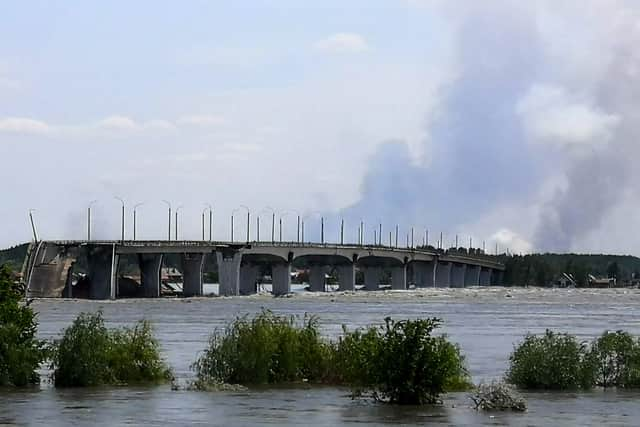Kakhovka dam collapse triggers emergency with thousands fleeing flooding as Ukraine and Russia trade blame
and live on Freeview channel 276
The collapse of a major dam in southern Ukraine has triggered an emergency with thousands of people at risk from flooding.
The onslaught of water has flooded homes and streets, endangered crops in the country’s breadbasket and threatened drinking water supplies.
Advertisement
Hide AdAdvertisement
Hide AdBoth Ukraine and Russia scrambled to evacuate residents with officials from both sides using terms like “ecological disaster” and “terrorist act” to describe the torrent of water gushing through the broken dam, as each side blamed each other for the destruction.
Ukraine accused Russian forces of blowing up the Kakhovka dam and hydroelectric power station which was built in the 1950s on the Dnieper River - in an area that Moscow has controlled for more than a year.
Russian officials blamed Ukrainian bombardment in the contested area, where the river separates the two sides. It was not possible to reconcile the conflicting claims.
Ukrainian President Volodymyr Zelensky called it “the largest man-made environmental disaster in Europe in decades”. UN secretary-general Antonio Guterres called it a “monumental humanitarian, economic and ecological catastrophe” and “another devastating consequence of the Russian invasion of Ukraine”.


Advertisement
Hide AdAdvertisement
Hide AdRishi Sunak said the destruction of the Kakhovka dam would mark a “new low” in the conflict if Russian forces were found to be responsible and that the immediate priority was the humanitarian response to the catastrophe.
He added that if it was an intentional act to blow up the dam it would be “the largest attack on civilian infrastructure” since the start of Putin’s war and the attacks were “appalling and wrong”.
Foreign Secretary James Cleverly described it as an “abhorrent act”, adding that “intentionally attacking exclusively civilian infrastructure is a war crime”.
But Evgeny Popov, a member of the Duma for Vladimir Putin’s United Russia party, claimed Ukraine would “profit” from the damage and said Russia is evacuating 22,000 people from the area. He accused Ukraine of a “war crime” by carrying out the attack.
Advertisement
Hide AdAdvertisement
Hide AdExperts have previously said the dam was in disrepair which could have led to the breach.
David Helms, a retired American scientist who has monitored the reservoir since the war began, said in an email it was not clear if the damage was deliberate or simple neglect from Russian forces occupying the facility. But Mr Helms also noted a Russian history of attacking dams.
A satellite photo on Tuesday morning (6 June) by Planet Labs PBC analysed by The Associated Press showed a large part of the dam’s wall with more than 600 metres (over 1,900ft) missing.
Ukraine’s nuclear operator Energoatom said via Telegram that the damage to the dam “could have negative consequences” for the Zaporizhzhia nuclear power plant, which is Europe’s biggest, but wrote that for now the situation is “controllable”.
Advertisement
Hide AdAdvertisement
Hide AdThe UN’s International Atomic Energy Agency reported “no immediate risk to the safety of the plant”, which has been shut down for months but still needs water for its cooling system.
Mykhailo Podolyak, a senior adviser to Mr Zelensky, said “thousands of animals and ecosystems will be destroyed”. One online video showed water inundating a long road while another showed a beaver scurrying for high ground.
Comment Guidelines
National World encourages reader discussion on our stories. User feedback, insights and back-and-forth exchanges add a rich layer of context to reporting. Please review our Community Guidelines before commenting.
